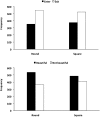Impact of contour on aesthetic judgments and approach-avoidance decisions in architecture
- PMID: 23754408
- PMCID: PMC3690611
- DOI: 10.1073/pnas.1301227110
Impact of contour on aesthetic judgments and approach-avoidance decisions in architecture
Abstract
On average, we urban dwellers spend about 90% of our time indoors, and share the intuition that the physical features of the places we live and work in influence how we feel and act. However, there is surprisingly little research on how architecture impacts behavior, much less on how it influences brain function. To begin closing this gap, we conducted a functional magnetic resonance imaging study to examine how systematic variation in contour impacts aesthetic judgments and approach-avoidance decisions, outcome measures of interest to both architects and users of spaces alike. As predicted, participants were more likely to judge spaces as beautiful if they were curvilinear than rectilinear. Neuroanatomically, when contemplating beauty, curvilinear contour activated the anterior cingulate cortex exclusively, a region strongly responsive to the reward properties and emotional salience of objects. Complementing this finding, pleasantness--the valence dimension of the affect circumplex--accounted for nearly 60% of the variance in beauty ratings. Furthermore, activation in a distributed brain network known to underlie the aesthetic evaluation of different types of visual stimuli covaried with beauty ratings. In contrast, contour did not affect approach-avoidance decisions, although curvilinear spaces activated the visual cortex. The results suggest that the well-established effect of contour on aesthetic preference can be extended to architecture. Furthermore, the combination of our behavioral and neural evidence underscores the role of emotion in our preference for curvilinear objects in this domain.
Keywords: curvature; design; habitat theory; neuroaesthetics.
Conflict of interest statement
The authors declare no conflict of interest.
Figures






References
-
- Klepeis NE, et al. The National Human Activity Pattern Survey (NHAPS): A resource for assessing exposure to environmental pollutants. J Expo Anal Environ Epidemiol. 2001;11(3):231–252. - PubMed
-
- Ott WR. 1989. Human activity patterns: A review of the literature for estimating time spent indoors, outdoors, and in transit. Proceedings of the Research Planning Conference on Human Activity Patterns, EPA National Exposure Research Laboratory, EPA/600/4-89/004: Las Vegas, NV.
-
- Stamps AE. Physical determinants of preferences for residential façades. Environ Behav. 1999;31(6):723–751.
-
- Lindal PJ, Hartig T. Architectural variation, building height, and the restorative quality of urban residential streetscapes. J Environ Psychol. 2013;33(1):26–36.
-
- Jones PB, Canniffe E. Modern Architecture Through Case Studies 1945--1990. Oxford: Architectural Press; 2007.
Publication types
MeSH terms
LinkOut - more resources
Full Text Sources
Other Literature Sources
Medical
Research Materials
Miscellaneous

